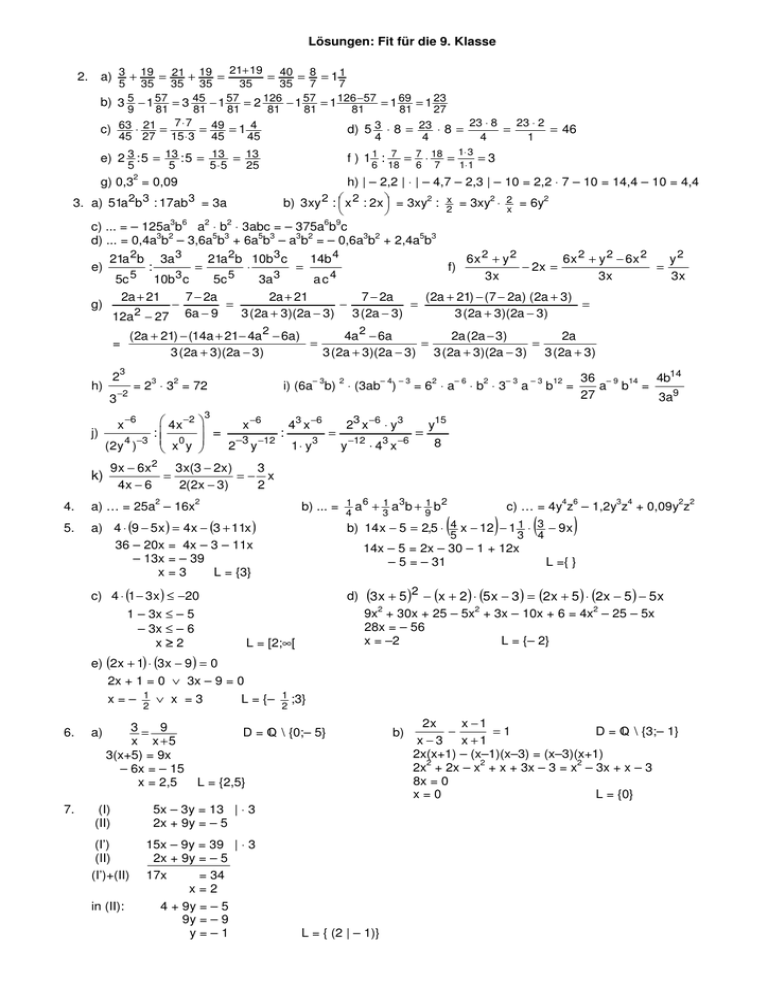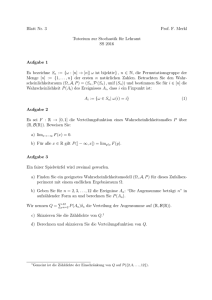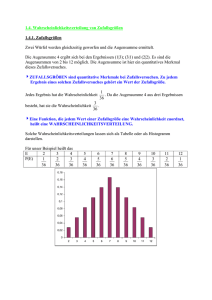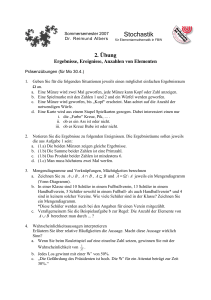Fit für 9 Lösung - Sigmund-Schuckert Gymnasium Nürnberg
Werbung

Lösungen: Fit für die 9. Klasse
21+ 19 40 8
2. a) 3 + 19 = 21 + 19 =
=
= = 11
5
35 35 35
35
35 7
7
5
57
45
57
126
57
126
−57 = 1 69 = 1 23
b) 3 − 1 = 3
−1 = 2
−1 = 1
9
81
81
81
81
81
81
81
27
7
⋅
7
23 ⋅ 8
23 ⋅ 2
= 49 = 1 4
c) 63 ⋅ 21 =
d) 5 3 ⋅ 8 = 23 ⋅ 8 =
=
= 46
45 27 15 ⋅ 3 45
45
4
4
4
1
1⋅ 3
=3
f ) 1 1 : 7 = 7 ⋅ 18 =
e) 2 3 : 5 = 13 : 5 = 13 = 13
5
5
5⋅5
25
6
2
g) 0,3 = 0,09
18
6
7
1⋅ 1
h) | – 2,2 | ⋅ | – 4,7 – 2,3 | – 10 = 2,2 ⋅ 7 – 10 = 14,4 – 10 = 4,4
2
2
2
b) 3 xy 2 : x 2 : 2 x = 3xy : x = 3xy ⋅ 2 = 6y
3. a) 51a 2b 3 : 17ab 3 = 3a
2
3 6
2
2
6 9
c) ... = – 125a b a ⋅ b ⋅ 3abc = – 375a b c
3 2
5 3
5 3
3 2
3 2
5 3
d) ... = 0,4a b – 3,6a b + 6a b – a b = – 0,6a b + 2,4a b
21a 2b 10b 3 c
14b 4
6x 2 + y 2
6 x 2 + y 2 − 6x 2
y2
⋅
=
f)
− 2x =
=
3x
3x
3x
5c 5 10b 3 c
5c 5
3a 3
ac4
2a + 21
7 − 2a
2a + 21
7 − 2a
(2a + 21) − (7 − 2a) (2a + 3)
g)
−
=
−
=
=
2
3 (2a + 3)(2a − 3) 3 (2a − 3)
3 (2a + 3)(2a − 3)
12a − 27 6a − 9
e)
21a 2b
2
3
j)
k)
:
=
(2a + 21) − (14a + 21− 4a 2 − 6a)
4a 2 − 6a
2a (2a − 3)
2a
=
=
=
3 (2a + 3)(2a − 3)
3 (2a + 3)(2a − 3) 3 (2a + 3)(2a − 3) 3 (2a + 3)
=
h)
3a 3
x
3
3
−2
x
2
–3
= 2 ⋅ 3 = 72
2
–4 –3
i) (6a b) ⋅ (3ab )
2
–6
=6 ⋅a
2
–3
⋅b ⋅3
a
–3
b
12
=
36 – 9 14 4b14
a b =
27
3a9
3
−6
(2y 4 )−3
4x −2
x −6
43 x −6
23 x −6 ⋅ y3
y15
:
=
:
=
=
x0 y
8
2−3 y −12 1 ⋅ y3
y −12 ⋅ 43 x −6
9x − 6x 2 3x(3 − 2x)
3
=
=− x
4x − 6
2(2x − 3)
2
2
b) ... = 1 a 6 + 1 a 3b + 1 b 2
2
4 6
3 4
4.
a) … = 25a – 16x
5.
a) 4 ⋅ (9 − 5 x ) = 4 x − (3 + 11x )
36 – 20x = 4x – 3 – 11x
– 13x = – 39
x=3
L = {3}
b) 14 x − 5 = 2,5 ⋅ 4 x − 12 − 1 1 ⋅ 3 − 9 x
c) 4 ⋅ (1 − 3 x ) ≤ −20
d) (3 x + 5 )2 − (x + 2) ⋅ (5 x − 3 ) = (2x + 5 ) ⋅ (2x − 5 ) − 5 x
2
2
2
9x + 30x + 25 – 5x + 3x – 10x + 6 = 4x – 25 – 5x
28x = – 56
x = –2
L = {– 2}
4
1 – 3x ≤ – 5
– 3x ≤ – 6
x≥2
3
9
(5
)
3
14x – 5 = 2x – 30 – 1 + 12x
– 5 = – 31
L = [2;∞[
2 2
c) … = 4y z – 1,2y z + 0,09y z
(4
)
L ={ }
e) (2x + 1) ⋅ (3 x − 9 ) = 0
2x + 1 = 0 ∨ 3x – 9 = 0
x=– 1 ∨ x =3
L = {– 1 ;3}
3= 9
x x +5
3(x+5) = 9x
– 6x = – 15
x = 2,5
D = Q \ {0;– 5}
2
6.
7.
a)
(I)
(II)
(I’)
(II)
(I’)+(II)
in (II):
2
L = {2,5}
5x – 3y = 13 | ⋅ 3
2x + 9y = – 5
15x – 9y = 39 | ⋅ 3
2x + 9y = – 5
17x
= 34
x=2
4 + 9y = – 5
9y = – 9
y=–1
L = { (2 | – 1)}
b)
2x
x −1
−
=1
D = Q \ {3;– 1}
x − 3 x +1
2x(x+1) – (x–1)(x–3) = (x–3)(x+1)
2
2
2
2x + 2x – x + x + 3x – 3 = x – 3x + x – 3
8x = 0
x=0
L = {0}
8. Nullstellen: 1 x + 2 = 0 ⇔ x = – 6
3
bzw. 1 – 2x = 0 ⇔ x = 0,5
y
4
Schnittpunkte: 1 x + 2 = 1 – 2x ⇔ x = – 3 ⇒ y = 1 6 ; S(– 3 ; 1 6 )
3
9.
7
7
7
3
7
2y = 3x – 6 ⇔ y = 1,5x – 3
1,5⋅20 – 3 = 27 < 28 ⇒
P liegt oberhalb der Geraden.
2
1
10. Durch Verschiebung um 2 nach rechts und 3 nach oben.
-3
-2
-1
O
1
2
3x
-1
y
6
-2
5
11. (180° – 50°) : 2 = 65°.
4
12. AAECD = 12, AE = 3 ⇒ h = 4;
2
EB = 4 ⇒ A∆EBC = 1 ⋅4⋅4 = 8 [cm ]
3
2
2
D
C
1
h
-1
O
1
2
3
4
5 x
-1
A
E
B
2
13. A = 1 a⋅b = 6 cm , und aus A = 1 c⋅ hc folgt hc = 2A = 2,4 cm.
2
2
c
40
⋅ AKreis =
360
40
uKreis = 2rπ ≈ 2 ⋅ 5 cm⋅3,14 = 31,4 cm ⇒ uBogen =
⋅ uKreis =
360
uSektor = uBogen + 2r ≈ 13,5 cm
14. AKreis = r²π ≈ (5 cm)²⋅3,14 = 78,5 cm² ⇒ ASektor =
1
⋅78,5 cm² ≈ 8,72 cm²
9
1
⋅31,4 cm ≈ 3,49 cm
9
40 °
5 cm
15. Die Dreiecke sind ähnlich, da sie in den 3 Winkeln (20°, 70° und 90°) übereinstimmen.
Der Ähnlichkeitsfaktor ist das Hypotenusenverhältnis 4:6 = 2 .
3
16. Der Ähnlichkeitsfaktor k ist das Verhältnis der Höhen 6:4 =1,5. Da alle Flächen mit k² und alle Volumina mit k³
wachsen, ist das Volumen der größeren Pyramide V’ = 1,5³ ⋅ V = 3,375 ⋅ 12 cm³ = 40,5 cm³ und ihre Oberfläche
O’ = 1,5² ⋅ O = 2,25 ⋅ 20 cm² = 45 cm².
17.
ZB 3,5
=
⇒ ZB = 5,6
4
2,5
ZE 4,5
=
⇒ ZE = 6,3 ⇒ CE = 2,8
3,5 2,5
ZD 3,5
ZA
5
=
⇒ ZD = 5
=
⇒ ZA = 8
4
2,8
4
2,5
18. Die Seitenhalbierenden eines Dreiecks teilen sich im Verhältnis 2:1.
19. Der Ergebnisraum Ω = { (1|1), (1|2), ... , (6|6)} enthält 36 gleichwahrscheinliche Ergebnisse, ist also ein
Laplaceraum. Das Ereignis „Augensumme 4“ ist die Menge {(1|3), (2|2), (3|1)}, es enthält also 3 Ergebnisse.
3
1
Damit ist die Wahrscheinlichkeit P(„Augensumme 4“) =
=
.
36 12



